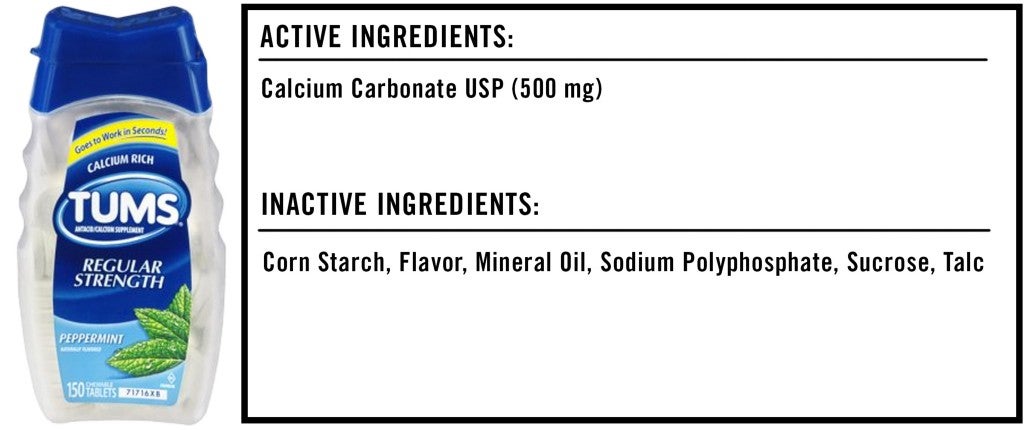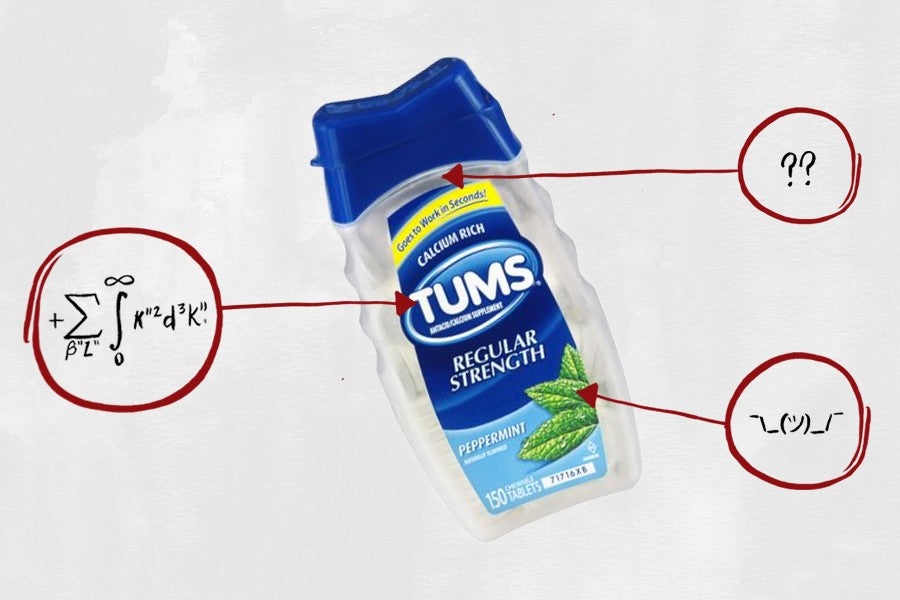We’re often told that you should never eat anything (or put anything on your body) if you don’t recognize everything on the ingredients list. But since most of us have no idea what xanthan gum or potassium benzoate are — or more importantly, what they’re doing to our bodies — we’re decoding the ingredients in the many things Americans put in (and on) themselves with the help of an expert.
This edition: TUMS Regular Strength (Peppermint), which is made from seven separate ingredients that we’ve broken down in the exact order they appear on their website.

The Ingredients
1) Calcium Carbonate: “Calcium carbonate is a mineral compound found in limestone, egg shells, pearls and many other natural sources,” explains Dagan Xavier, ingredient expert and co-founder of Label Insight. “It’s the active ingredient in some over-the-counter antacid medications and functions by neutralizing gastric hydrochloric acid and by inhibiting the key digestive enzyme pepsin.” In simpler terms, it prevents stomach acid from irritating the lining of your stomach.
For best results, taking calcium carbonate before a greasy meal provides relief for about a half-hour. You can also take calcium carbonate after eating for longer-lasting relief (between one and two hours).
People who are already taking calcium supplements should avoid this ingredient, since too much calcium can result in a calcium overdose. Symptoms of such an overdose include kidney stones, fatigue, muscle weakness, nausea and vomiting, frequent urination, changes in heart rate, confusion, constipation or diarrhea, headaches and coma.
You’ve been warned.
2) Corn Starch: Derived from corn kernels, corn starch is used in pharmaceutical products as a disintegrant (enabling the tablet to dissolve so that the drug can be absorbed) and binder (which holds the tablet together until it hits your tongue).
3) Flavor: While natural flavors are quite literally flavors derived from an actual food source — i.e., peppermint taken from a real peppermint plant — artificial flavors are chemical compounds created in a lab that mimic a natural flavor in some way. Whether the flavor in TUMS is natural or artificial isn’t clear, but it doesn’t matter much either way: Neither are a real cause for concern.
4) Mineral Oil: This treats constipation by keeping your digestive tract (and the stool passing through it) moist. Good to know!
5) Sodium Polyphosphate: Similar to mineral oil, sodium polyphosphate treats constipation. It’s also used to prepare the bowel for medical procedures.
6) Sucrose: Sucrose is just a fancy term for table sugar, which is added to medications (especially chewable tablets) to impart a sweet flavor to otherwise unpalatable chemicals.
7) Talc: In TUMS, talc acts as a glidant to ensure that the active ingredient (calcium carbonate) evenly coats your stomach. But as we learned in our exploration of the ingredients in Gold Bond Body Powder, talc is a controversial ingredient:
In its natural mineral form, some talc contains asbestos, a substance known to cause cancer in and around the lungs when inhaled. Despite the fact that modern cosmetic [and pharmaceutical] products are believed to contain asbestos-free talc, a 2014 study found that “one historic brand of cosmetic talcum powder” (left unnamed by the researchers) released inhalable asbestos fibers into the air when applied, which were then linked to the formation of pleural mesothelioma (aka lung cancer).
A few other major studies also found a link between talc and ovarian cancer — many women in particular use products containing talc (like baby powder) as a part of feminine hygiene — but none have proven direct causation. As a result, The American Cancer Society states on its website: “Studies of personal use of talcum powder have had mixed results, although there is some suggestion of a possible increase in ovarian cancer risk.”
The Takeaway
The only real worrisome ingredient in TUMS is talc, which is admittedly alarming (even though the research isn’t exactly conclusive). That said, the relief that TUMS can provide after a regrettable trip to Taco Bell — or a regrettable night of tequila shots — probably outweighs the small risk that comes with occasionally consuming a hint of talc.
So go ahead, and TUM it up.

